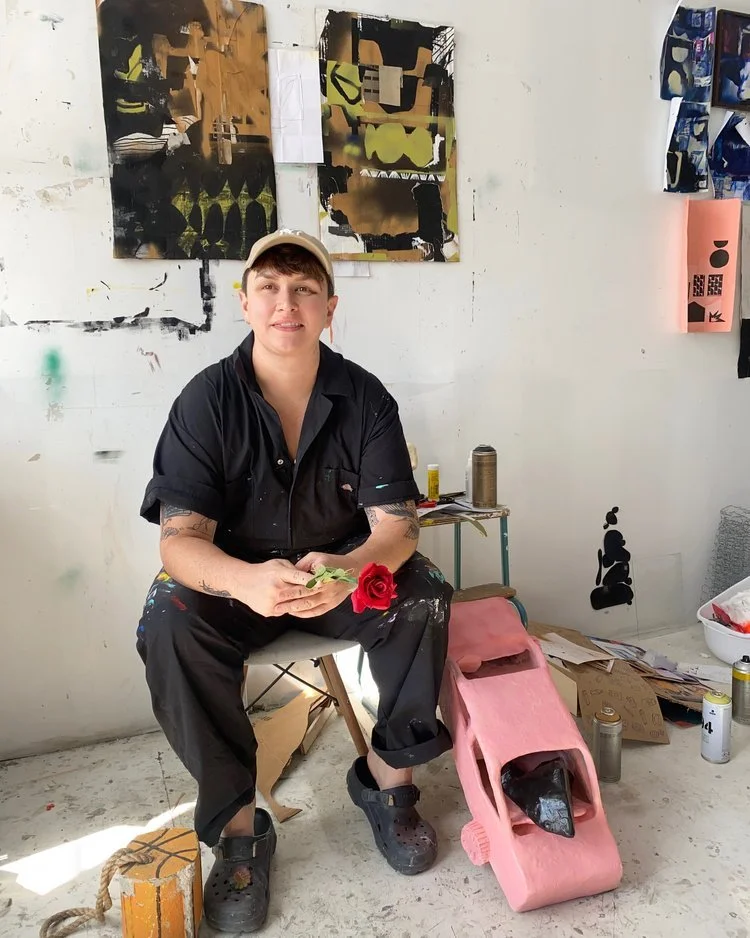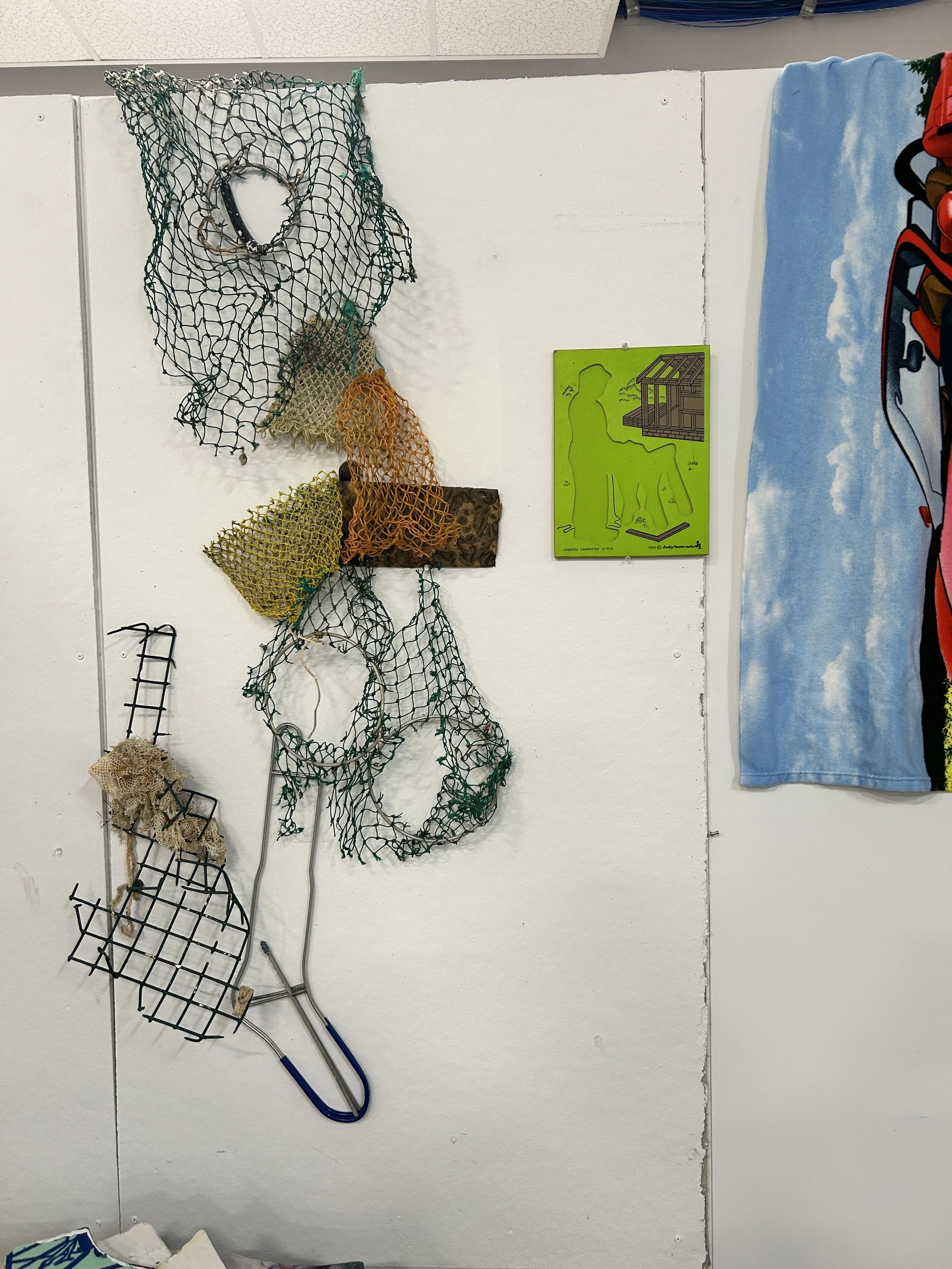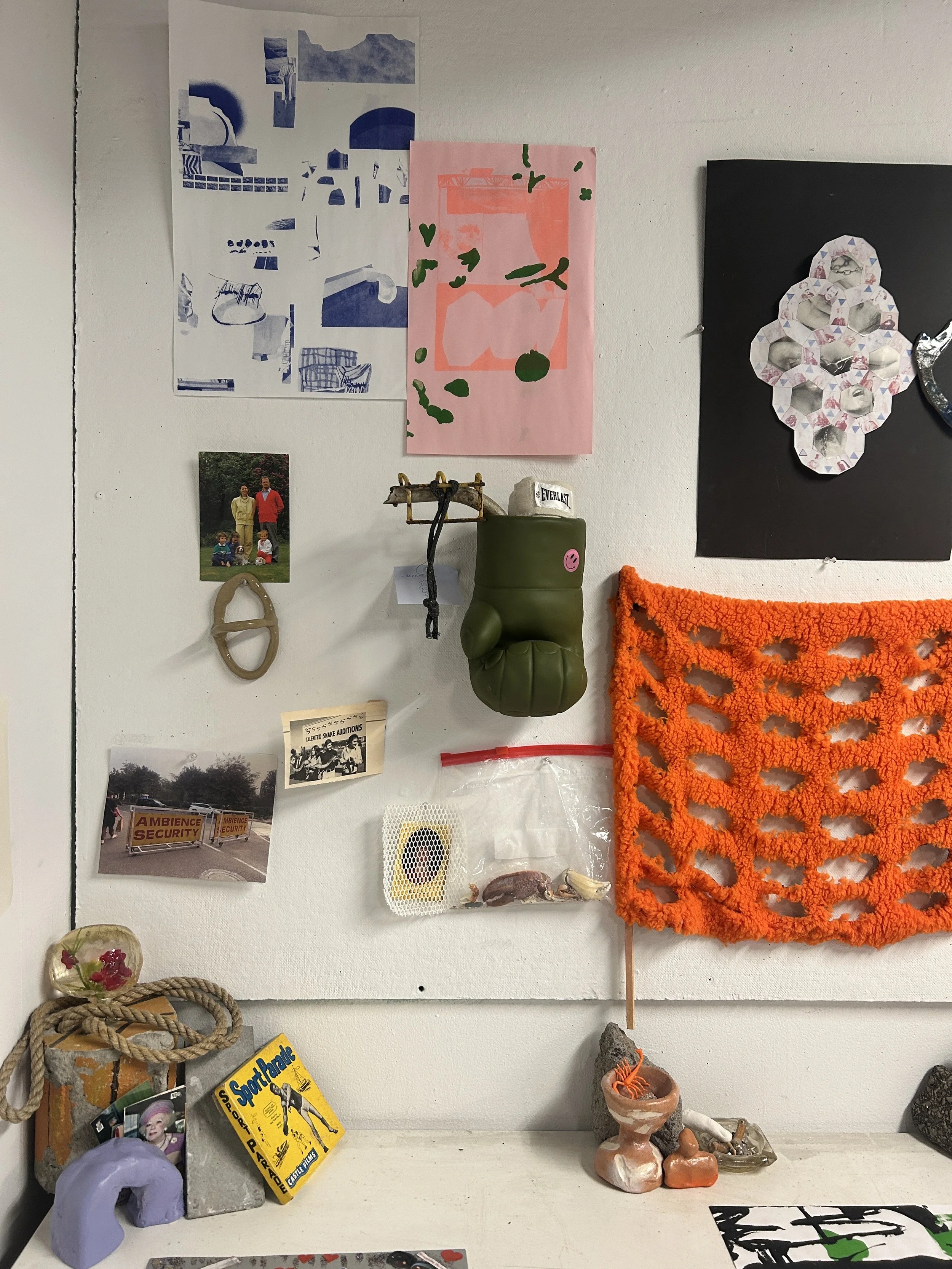Ryan Swedenborg
Ryan Swedenborg (Concord, CA) is a visual artist, designer, and sculptor, who currently lives and resides in Portland, ME. In her experience of the world Swedenborg looks towards reflective puddles, the armature of twigs, and the sparkling arches of rainbows to draw us towards the delight of our natural world. Swedenborg pricks us to take pause within the sparkle of a moment either found in the cracks of a sidewalk where the will of humans have laid waste to the natural order of things. Yet, the awe of nature exacts its revenge through the grey of the concrete to demand its freedom. Also being found in the forms of sculptures capturing the essence of a breath of fresh air and the timidness we should hold in relation to the objects and our environment. For Swedenborg, a grassroots embodiment is found in the rosy promise of calmness, where an uneven, often broken, concrete grey — or brick red in Portland’s case — a commonplace sidewalk becomes a bridge allowing for the viewer to traverse across to a better world. Sidewalk #1 and Sidewalk #2, are figurative compositions taken from the literal representations of the paths we walk on. Sometimes taking form as abstract puddles after a heavy rainfall, becoming the buildings that cast tall shadows, or becoming the graffiti found in the alleyways and on the surfaces of untouched places [think the Portland Bee]. This work, in its blues, whites, greys, and magentas asks us to take a walk for the betterment of all of us. Swedenborg kindfully reminds us that, as bleak as it may get, all is not lost and shows the most urgency is sometimes held in moments of radical joy.In Conversation with Ryan Swedenborg: “The coexistence that takes place brings me joy and honestly optimism. It is a wonderful chance bricolage.”
Ryan Swedenborg, thank you for taking the time to submit work for our exhibition, Grassroots. I am equally happy that you were on board to sit down (at your computer or on your phone) to complete an online interview with Easthaus. Let's get started!
Easthaus:
Ryan Swedenborg:
We have had the privilege of our creative paths crossing each other through our MFA program at MECA&D but I still want to give you the space to offer our community a glimpse into your life and practice as an artist. How would you describe your time in the studio? What is a successful day for you? How do you approach a new project or artwork? Where do you start? Where do you know when to end?
EH:
Hi hello! Happy to be talking with y’all and to be included in Grassroots.
Whoop, MECA&D!
My time in the studio shifts depending on what I need. Sometimes, it feels like a lab for testing prototypes, sometimes a gym to build up my understanding of movement, a temple for meditation, or a recycling center where I sort and document. Regardless of need, I keep some rituals in place when I enter the studio. It takes a bit for me to seep into the headspace fully—utility acts, like hiding my phone, doing some stretching, and doing a timed warm-up not related to the project of focus, get me grounded. Recently I have been doing ceramic slip casting as my warm up. Getting an object to take shape so quickly is very motivating.
If time is not a factor in the conclusion I usually go until I'm exhausted, so I can’t overthink anymore and must lean into the gut feeling to get an answer.
RSw:
That gut feeling is too spot on sometimes too and knowing your work, you approach projects from a large array of processes and mediums, most recently as sculptural installations, but collage and assemblage seem to be cornerstones in your practice. What draws you to the interdisciplinary approach to making work or do you consider it all as installation? French artist, David Douard, comes to mind when thinking of blending 2-D with 3-D and installation. I am curious who is in your artistic family tree historically and who do you consider as your current contemporary colleagues? Who do you find yourself in dialogue with?
EH:
Oh yes, I am a big Douard fan. I especially love his use of very vibrant colors that draw you into the chaos and give you no choice but to sit with it for a moment. When I look at my sculptural lineage, I find myself drawn to artists who enjoy some play and humor but are tactical with their absurdity. Artists who have created works that stand comfortably in irreconcilability. Robert Rauschenberg and Eva Hesse feel like my grandparents; their ability to choreograph a variety of objects and let each piece have its own voice but still feel unified mesmerizes me.
A bit of cheekiness will always interest me. I’m constantly looking at Rachel Harrison and Phyllida Barlow as they poke and prod the viewer with these often goofy-looking forms that hold so much tension. It leaves you searching for, needing some type of release. Artists like Ser Serpas and Abigail Deville remind me to enjoy the uncomfortable reality, be brave, and sit in that feeling.
All these artists live in some type of assemblage sculptural space. I like this 3D collage approach as it is collaborative. I love a group project (someone has to be that person). Working with the space and the materials/ objects to attempt to create a choreography really energizes me.
RSw:
EH:
I am so glad you know of Douard, we happened to stumble onto his exhibition, ACHéTE LE NACRé à LEURS âMES, at Konrad Fischer Galerie in Berlin. Not only are you correct on his color usage but I think he also access the tension you speak of as well; a cyber-cheek aesthetic if you will. As artists we all have different views about what it means to be an artist and to hold a creative practice. In our contemporary moment, it’s seemingly even more important now to be a creative person. Would you mind telling us what your overall philosophy about art is? What keeps bringing you back to the studio? What do you feel is your role as an artist in this greater societal grassroot movement we are living though?
Art can serve in so many ways. For me, for the last couple years, my creative practice has served as a way to stay human. To make time and space to seek alternatives, for critique, for pleasure, for discomfort. Art shows me how important it is to experience these feelings with others. Exploring through art has given me more confidence to ask myself, and sometimes others I'm in conversation with, “why not?” As artists I find that’s a big part of our call to action, to ask “Why?” and present some other possibilities.
RSw:
In your artist statement you mention that your work looks to offer us “moments of gratefulness toward the flickers of utopia found in nature”, and it reminded me that urgency does not need to be solely held in a transformative call to action but can find its power in taking pause, in drawing in a big deep breath; and releasing radical optimism. A feeling of taking that deep breath seems to be where you look to place your work. When thinking about our societal and ecological climate today that's a powerful move to ask us to make. From this lens, what are some of the other ways you feel that your work approaches our societal grassroots movement? Does the deep breath read ring true for you or is something embedded deeper in the work? Are you speaking to the landscapes we have transformed or to the people who traverse our infrastructure; maybe both?
EH:
The rate in which information is presented to us and consumed is at an exhaustingly fast rate, which can feel like if we take a pause we might fall behind somehow. I have been trying to make more space for those pauses, little flickers of curiosity or just pure delight. It’s no small ask. My works recently feel like recreations of those moments, and also an “thank you” for the moment. Maybe I’m doing a bit of dopamine seeking trying to recreate them?
The encounters that delight me the most are when the built environment/human made have an accidental collaboration with nature. The coexistence that takes place in this meeting brings me joy and honestly optimism. It is a wonderful chance bricolage.
RSw:
I find it always interesting to see what artists have pinned up on their walls; deadlines, to-do lists, art inspiration/mood boards, ect. It says a lot about how the artist's mind works and how they connect the dots and how it all feeds into the work. Do you have any images from the studio you would like to share with us? What do you have up on your walls currently?
EH:
This was fun to take a look around my studio and document these moments I have in my studio. I always have little collections up in parts of my studio. If an object resonates with me I make sure it’s in my eyeshot for a couple of weeks until I figure out what role it is looking for and what other forms it can work well with.
RSw:
EH:
Ryan, thank you for your time contributing to the conversation for the exhibition, Grassroots, which is on view until February 28th here at Easthaus. For a closing dialogue on this interview we welcome you to plug any ongoing projects, events, upcoming thoughts, inspirational quotes; anything that you would like to share with the Easthaus and greater art community we are fostering.
Thank you so much for setting up this discussion y’all. As I am currently in the throes of my last term of grad school, it was delightful to take a step back and think + discuss pauses via art. A good reminder to myself to keep taking them.
I’m in a show with Ian Trask at See/Saw Gallery in Manchester, New Hampshire this month. I’ve been a fan of his for a few years, so I’m excited to show with him. Check it out if you’re in the area.
RSw:




